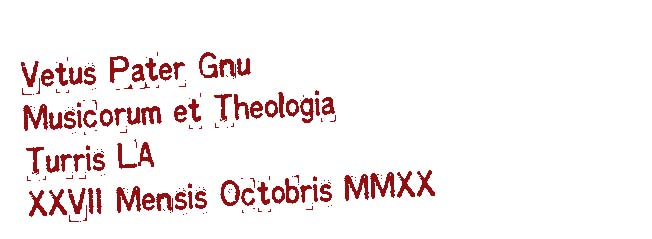
The burning question in Old Gnu’s mind at the moment is, just precisely who was John Bull? Was he indeed the manufacturer of a printing set young Gnu received a Christmas present at the age eight, and that fascinated him for a long time?
In retirement Old Gnu has had a chance to pursue these important and burning questions. There have been at least three notable British citizens, a magazine, and a dreadful ship of this name, and numerous American ones including a horse and a railway locomotive. Today Old Gnu will speak only of these notable Englishmen, and express his bewilderment.
The first notable Englishman of this name was Dr. John Bull [1562-1628] the composer, who was renown as a performing musician and organ builder. It is fairly certain that he did not manufacture printing sets.
His illustrious career took him from Children of the Chapel Royal, to Organist of Hereford Cathedral in 1582, organist of the Chapel Royal in 1586, a Doctorate from Oxford in 1592 and in 1596 Professor of Music at Gresham College on the recommendation of Queen Elizabeth who is said to have admired him.


However, his genius and his virtuosity as a performer was equalled by his skill at getting into trouble. He used a stone mason to break into rooms which he felt he should occupy on account of his position at Gresham College. [Had he considered the easier option of breaking the door down?] This led to a court action against him.
Ten years later he was forced to leave his post at Gresham College because he had fathered a child outside marriage. While this seems perfectly normal behaviour for some eminent people today, it “wasn’t on” in 1607, and poor Dr. John lost his salary and living quarters to boot.
In 1613 the Archbishop of Canterbury said:
“The man hath more music than honesty, and is as famous for marring of virginity as he is for fingering of organs and virginals.” [Dear reader, this is an unfortunate juxtaposition of words with more than one meaning. Organs and Virginals could refer to musical instruments in this context. Perhaps Archbishop George Abbot had a sense of humour.]

Is there a suppressed grin on his face?
Dr. John is also known to have assaulted a church minister in front of the congregation. Old Gnu knows this to be a great temptation for many organists. Especially when they are straining every ounce of concentration playing the final organ voluntary [which they have practiced for weeks], and the vicar interrupts over the microphone to tell the congregation that it is Gladys’ birthday; and perhaps we could all sing a rousing chorus of Happy Birthday.
But, really and truly, it is better to count up to ten, which clearly Dr. John, even though he was a D.Mus, was incapable of doing.
In 1613 things came to a head when Dr. John secretly fled the country in in great haste. Apparently this time he was fleeing the wrath of Archibishop George Abbot Cantaur and King James I [who later lost his head, but not on this account]; yep, once again, the charge was adultery.
Dr. John ended up in Flanders. The Royal Court in Flanders couldn’t believe their luck at having landed such a musical genius of Dr. John’s quality and employed him, no questions asked. That is, until King James I put in a complaint. Thereafter it seems that Dr. John was paid for a while, though was not seen to be performing officially in public – a bit like Dominic Cummings.
However, Antwerp Cathedral appointed him Assistant Organist in 1615 and on account of his peerless moral integrity Principal Organist in 1617.

Thereafter he seems to have stayed out of trouble and was buried on 15th March 1628, after he had died, in the cemetery by Antwerp Cathedral, though Archbishop George and King James would have probably preferred it before.
And what of his music? He is a first rate composer. Hearken unto Mr. Waki Pedia:
One of the most unusual collections of music … is his book of 120 canons, an astonishing display of contrapuntal skill worthy of Ockeghem or J.S. Bach.
Because he fled England in haste, much of his music was lost or stolen by other composers, like Old Gnu and Andrew Lloyd Webber. His use of chromaticism in a couple of his pieces is akin to that Count Carlo Gesualdo, Prince of Venosa, who was an exact contemporary [1568 to 1613].

Prince of Venosa
Count Gesualdo killed his wife and a man found together in his bedroom on the spot – no questions asked, and obviously none answered. It seems he was a better shot than King James. It’s a good job Dr. John didn’t cross paths with Count Gesualdo’s wife. Later in life Gesualdo is said to have suffered from depression. Dr. John showed no such signs.
The next John Bull of note died in 1641. We do not know his birth date. He was a proficient weaver, for a person of his name was accepted into London’s “Worshipful Company of Weavers” during his lifetime.

In the 1630s he declared himself to be a prophet; and no ordinary prophet at that. He claimed to be one of the 2 witnesses in the Book of Revelation. However, he came from Essex, together with the other witness, Richard Farnham [from Colchester]. At the time of The Great Plague both these prophets declared that “the plague should not come near their dwelling”. [cf. Psalm 91]. However, like Mr. Trump, they both caught the Plague and died within 10 days of each other – is Mr. Trump still alive? Prophet John Bull’s followers declared that he had risen from the dead, together with Prophet Richard, in accordance with the prophecy in the Book of Revelation, and had “gone in a vessel of bulrushes to convert the 10 tribes”… the lost 10 tribes of Israel. So presumably they weren’t seen in Essex again.
Mr. Waki Pedia informs us that pamphlets were written the year of their deaths and mentions 2 of them:
“False Prophets Discovered, being a true story of the Lives and Deaths of two weavers, late of Colchester, viz. Richard Farnham and John Bull …”, London, 1641[–2].
“A Curb for Sectaries and bold propheciers, by which Richard Farnham the Weaver, James Hunt the Farmer, M. Greene the Feltmaker, and all other the like bold Propheciers and Sect Leaders may be bridled”, London, 1641.

The third John Bull of note from our shores was the figment of the imagination of John Arbuthnot [1667 – 1735].

He was a Scottish Physician [to the Monarchy] and a satirist; and is best remembered for his contributions to Mathematics. He was a veritable polymath.
Hearken once more unto Mr. Waki Pedia:
“John Bull first appeared in 1712 in Arbuthnot’s pamphlet Law is a Bottomless Pit. The same year Arbuthnot published a four-part political narrative The History of John Bull. In this satirical treatment of the War of the Spanish Succession John Bull brings a lawsuit against various figures intended to represent the kings of France (Louis Baboon) and Spain (Lord Strutt) as well as institutions both foreign and domestic.”
And so the figure of John Bull grew and was taken up by satirists and a multitude of publication. John Bull himself continued to frequently appear as a national symbol in posters and cartoons as late as World War I, comme ça:

And more cartoons of Mr. Bull who earlier was depicted as as an actual humanoid bull:


John Bull walking off with Marianne, turning his back on the Kaiser.
So you see see my Little Gnudren, in the words of the Authorized Version of the Holy Scriptures, we British are “a peculiar people.” For we have taken the name of two outstandingly notorious figures of our national history and given them to an iconic figure who in part epitomised the spirit of our nation for a couple of centuries. Perhaps the Scot in Dr. John Arbuthnot is killing himself with laughter.
Good day!


